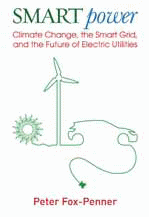SEJournal Online is the digital news magazine of the Society of Environmental Journalists. Learn more about SEJournal Online, including submission, subscription and advertising information.

BookShelf
Smart Power: Climate Change, the Smart Grid, and the Future of Electric Utilities
By Peter Fox-Penner
Island Press, $30
Reviewed by JENNIFER WEEKS
Electric power was one of the transforming advances of the 20th century, freeing Americans from manual labor and laying the foundation for a knowledge-based economy. But the U.S. electricity industry is profoundly ill-suited to address two of today's most pressing challenges: climate change and energy security. It has a motley economic and legal structure, partly deregulated and partly run under the old utility model; the national power grid is old and under strain; and we use too much fossil fuel.
In Smart Power, energy consultant Peter Fox-Penner asserts that the power industry needs to completely redesign itself. In a 21st-Century power system, information and electricity will flow back and forth between utilities and customers. Generators will use more low-carbon fuels, and power companies will promote energy efficiency as intensively as they sell kilowatt-hours. The trick is getting there from here — a challenge that Fox-Penner compares to "rebuilding our entire airplane fleet, along with our runways and air traffic control system, while the planes are all up in the air filled with passengers."
To explain why it's hard to make large-scale change in the power industry, Fox-Penner provides a useful explanation of how utilities deliver electricity. The grid is designed to send power one way: from central generating stations to users. We don't have large-scale technologies for storing electricity yet, so power has to be consumed as soon as it is generated, and the amount of power flowing into and out of the transmission grid has to be kept constantly in balance. Those features make it hard to add a lot of renewable energy and distributed generation to the system, since renewable fuels like wind and solar power are intermittent, and adding local generation sources complicates the task of balancing power in the area around them.
Making matters worse, botched attempts to deregulate electricity markets in the 1990s left the industry with a messy and complicated structure. Utilities may be publicly or privately owned, operate in deregulated or traditionally regulated states, and sell power either to other energy companies or directly to homes and businesses. All of these factors affect how they are regulated, and shape their goals and business plans.
One thing power companies agree on, however, is that we urgently need a smarter electric grid. This transition is already under way in many places. Some companies are adding sensors and phasor management units to long-distance transmission networks, so that they can detect system overloads and outages quickly and route power around them. Retail electricity providers are installing smart metering systems, which provide customers with information about how much power they use at given times and what it really costs to generate that power (not the uniform "dumb" prices per kilowatt-hour that appear on conventional electric bills). And manufacturers are designing smart appliances that will communicate directly with smart meters and thermostats to regulate home energy use, guided by limits that homeowners program into them.
Fox-Penner sees smart metering as the most transformative part of the smart grid because it makes it possible for utilities to shift to dynamic pricing — charging more for power at times when it costs more to generate, such as on hot summer afternoons when demand for air conditioning peaks. He cites studies showing that with dynamic pricing customers typically reduce their peak power use by five to twenty percent, depending on how the programs are designed. That reduces overall power costs and the need to build new generating plants and transmission lines to meet peak demand.
Utilities also need to extend the grid into new regions where renewable sources are concentrated, especially the Plains states for wind and the Southwest for solar. We still don't have a national renewable electricity portfolio standard (RPS), but taken together, the 31 RPSs in force today will require a fivefold increase in national use of renewable power by 2030. Fox-Penner estimates that connecting up new clean electricity sources will require building 30,000 to 40,000 miles of new high-voltage transmission lines over the next 20 years. If we can't get that done, he argues, we won't have the supply choices we need to shrink the power sector's carbon footprint.
In the last section of the book (which is dense but worth working through), Fox-Penner lays out two alternate business models for the utility of the future. The Smart Integrator utility operates its section of the grid, delivering electricity reliably from many different sources. It provides some basic information about energy efficiency to customers, but its core role is still to sell power.
The Energy Services utility is a very different kind of company: it works to deliver lowest-cost energy services to customers, which can mean helping them buy less power. The smart grid supports this approach, since utilities can use it to help customers manage and reduce their electricity use, but Fox-Penner says it's not enough: we also need new laws and regulations that let power companies profit from saving energy. Some utilities, such as Duke Power and Austin Energy, are moving in this direction, but it requires a radical rethinking of what utilities are for — a job that falls mainly to state legislatures, governors, and public utility commissions that make the rules for the electricity industry. Smart Power makes clear how hard that transition will be, but also how it could pay off.
Freelancer Jennifer Weeks lives and writes in Watertown, Mass.
* From SEJ's quarterly newsletter SEJournal, Summer 2010 issue.











 Advertisement
Advertisement 



